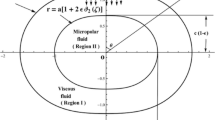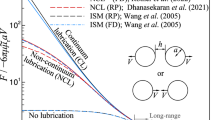Abstract
This paper presents an analytical study of Stokes flow of an incompressible viscous fluid through a swarm of immiscible Reiner–Rivlin liquid droplets-in-cell using the cell model technique. The stream function solution of Stokes equation is obtained for the flow in the fictitious envelope region, while for the inner flow field within the liquid drop, the solution is obtained by expanding the stream function in a power series of S. The proper boundary conditions are taken on the surface of the liquid sphere, while the appropriate conditions applied on the fictitious boundary of the fluid envelope vary depending on the kind of cell-model. The analytical solution of the problem for four models: Happel’s, Kuwabara’s, Kvashnin’s and Mehta–Morse’s model (usually referred to as Cunningham’s) is derived. The velocity profile and the pressure distribution outside of the droplet are shown in numerous graphs for different values of the parameters. Numerical results for the normalized hydrodynamic drag force \(W_{C}\) acting, in each case, on the spherical droplet-in-cell obtained for different values of the parameters characterizing volume fraction \(\gamma ,\) the relative viscosity \(\lambda\), and the cross-viscosity, i.e., S are presented in tabular and graphical forms as well. It is found that normalized hydrodynamic drag force \(W_{C}\) is a monotonic increasing function of particle volume fraction \(\gamma .\) It is also observed that solid sphere in-cell experiences greater drag force \(C_{D}\), whereas spherical bubble experiences smaller. One of the important findings of the present investigation is that the cross-viscosity \(\mu _{c}\) of Reiner–Rivlin fluid decreases \(W_{C}\) on the liquid droplet-in-cell. Further, the drag coefficient \(C_{D}\) get reduced to analytical results obtained earlier.












Similar content being viewed by others
References
Abramowitz M, Stegun IA (1970) Handbook of mathematical functions. Dover, New York
Bart E (1968) The slow unsteady settling of a fluid sphere toward a flat fluid interface. Chem Eng Sci 23:193–210
Brenner H (1957) Eng. Sc. D. thesis, New York University, New York
Choudhuri D, Sri Padamavati B (2010) A study of an arbitrary Stokes flow past a fluid coated sphere in a fluid of a different viscosity. Z Angew Math Phys 61:317–328
Cunningham E (1910) On the velocity of steady fall of spherical particles through fluid medium. Proc R Soc Lond Ser A 83:357–369
Dassios G, Hadjinicolaou M, Coutelieris FA, Payatakes AC (1995) Stokes flow in spheroidal particle-in-cell models with Happel and Kuwabara boundary conditions. Int J Eng Sci 33:1465–1490
Datta S, Deo S (2002) Stokes flow with slip and Kuwabara boundary conditions. Proc Ind Acad Sci (Math Sci) 112:463–475
Deo S, Gupta BR (2009) Stokes flow past a swarm of porous approximately spheroidal particles with Kuwabara boundary condition. Acta Mech 203:241–254
Deo S, Shukla P (2009) Creeping flow past a swarm of porous spherical particles with Mehta–Morse boundary condition. Indian J Biomech 7–8:123–127
Deo S (2009) Stokes flow past a swarm of deformed porous spheroidal particles with Happel boundary condition. J Porous Media 12:347–359
Datta S, Raturi S (2014) Cell model for slow viscous flow past spherical particles with surfactant layer coating. J Appl Fluid Mech 7:263–273
Faltas MS, Saad EI (2012) Slow motion of a porous eccentric spherical particle-in-cell models. Transp Porous Media 95:133–150
Gupta BR, Deo S (2013) Axisymmetric creeping flow of a micropolar fluid over a sphere coated with a thin fluid film. J Appl Fluid Mech 6:149–155
Happel J (1958) Viscous flow in multi particle system: slow motion of fluids relative to beds of spherical particles. AIChE J 4:197–201
Happel J (1959) Viscous flow relative to arrays of cylinders. AIChE J 5:174–177
Happel J, Brenner H (1983) Low Reynolds number hydrodynamics. Martinus Nijhoff, The Hague
Hetsroni G, Haber S (1970) The flow in and around a droplet or bubble submerged in an unbounded arbitrary velocity field. Rheol Acta 9:488–496
Jaiswal BR, Gupta BR (2014) Drag on Reiner–Rivlin liquid sphere placed in a micro-polar fluid with non-zero boundary condition for microrotations. Int J Appl Math Mech 10:90–103
Jaiswal BR, Gupta BR (2015) Brinkman flow of a viscous fluid past a Reiner–Rivlin liquid sphere immersed in a saturated porous medium. Transp Porous Media 7:907–925
Jaiswal BR, Gupta BR (2014) Wall effects on Reiner–Rivlin liquid spheroid. Appl Comput Mech 2:157–176
Jaiswal BR, Gupta BR (2015) Stokes flow of polar fluid past a non-Newtonian liquid spheroid. Int J Fluid Mech Res 42:170–189
Jaiswal BR, Gupta BR (2014) Reiner–Rivlin liquid sphere in an approximate spherical container (communicated)
Keh HJ, Lee TC (2010) Axisymmetric creeping motion of a slip spherical particle in a non-concentric spherical cavity. Theor Comput Fluid Dyn 24:497–510
Keh MP, Keh HJ (2010) Slow motion of an assemblage of porous spherical shells relative to a fluid. Transp Porous Media 81:261–275
Kim S, Karrila SJ (1991) Micro hydrodynamics: principles and selected applications. Butterworth-Heinemann, Boston
Kuwabara S (1959) The forces experienced by randomly distributed parallel circular cylinders or spheres in a viscous flow at small Reynolds numbers. J Phys Soc Jpn 14:527–532
Kvashnin AG (1979) Cell model of suspension of spherical particles. Fluid Dyn 14:598–602
Mehta GD, Morse TF (1975) Flow through charged membranes. J Chem Phys 63:1878–1889
Ramkissoon H, Majumadar SR (1976) Drag on axially symmetric body in the Stokes’ flow of micropolar fluids. Phys Fluids 19:16–21
Ramkissoon H (1989) Slow flow of a non-Newtonian liquid past a fluid sphere. Acta Mech 78:73–80
Ramkissoon H (1989) Stokes flow past a Reiner–Rivlin liquid sphere. J Appl Math Mech (ZAMM) 69:259–261
Ramkissoon H (1998) Stokes flow past a non-Newtonian fluid spheroid. J Appl Math Mech (ZAMM) 78:61–66
Ramkissoon H (1999) Polar flow past a Reiner–Rivlin fluid sphere. J Math Sci 10:63–68
Ramkissoon H, Rahaman K (2001) Non-Newtonian fluid sphere in a spherical container. Acta Mech 149:239–245
Reiner M (1945) A mathematical theory of dilatancy. Am J Math 67:350–362
Saad EI (2012) Cell models for micropolar flow past a viscous fluid sphere. Meccanica 47:2055–2068
Saad EI (2012) Stokes flow past an assemblage of axisymmetric porous spheroidal particle-in-cell models. J Porous Media 15:849–866
Saad EI (2013) Stokes flow past an assemblage of axisymmetric porous spherical shell-in-cell models: effect of stress jump condition. Meccanica 48:1747–1759
Stokes GG (1851) On the effect of the internal friction of fluid on pendulums. Trans Camb Philos Soc 9:8–106
Uchida S (1954) Slow viscous flow through a mass of particles. Ind Eng Chem 46:1194–1195 (transl: T. Motai)
Vasin SI, Filippov AN, Starov VM (2008) Hydrodynamic permeability of membranes built up by particles covered by porous shells: cell models. Adv Colloid Interface Sci 139:83–96
Yadav PK, Tiwari A, Deo S, Filippov A, Vasin S (2010) Hydrodynamic permeability of membranes built up by spherical particles covered by porous shells: effect of stress jump condition. Acta Mech 215:193–209
Zholkovskiy EK, Shilov VN, Masliyah JH, Bondarenko MP (2007) Hydrodynamic cell model: general formulation and comparative analysis of different approaches. Can J Chem Eng 85:701–725
Acknowledgments
Authors acknowledge with thanks to Department of Mathematics, JUET, Guna (M.P.) for providing necessary facilities during the preparation of this research paper. Further, the authors acknowledge their sincere thanks to the anonymous reviewers/referees of the paper for making their useful and valuable comments and giving fruitful suggestions which led to much significant improvement in the presentation of the manuscript.
Author information
Authors and Affiliations
Corresponding author
Appendix: Determination of arbitrary unknowns
Appendix: Determination of arbitrary unknowns
Applying the boundary conditions (36)–(39), and one condition from (40)–(43), we obtain the resulting equations for different models as follows.
1.1 For Happel model
1.2 For Kuwabara model
1.3 For Kvashnin model
1.4 For Cunningum/Mehta–Morse model
The solution of these systems of Eqs. (62)–(65), for different models are as follows.
1.5 For Happel model
where
1.6 For Kuwabara model
where
1.7 For Kvashnin model
where
1.8 For Cunningum/Mehta–Morse model
where
and
Rights and permissions
About this article
Cite this article
Jaiswal, B.R., Gupta, B.R. Cell models for viscous flow past a swarm of Reiner–Rivlin liquid spherical drops. Meccanica 52, 69–89 (2017). https://doi.org/10.1007/s11012-016-0385-3
Received:
Accepted:
Published:
Issue Date:
DOI: https://doi.org/10.1007/s11012-016-0385-3




